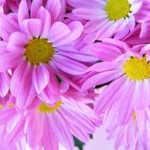The Chrysanthemum flower originates from China and Japan and varieties have been grown in gardens for more than 1000 years. The original Chrysanthemum have been developed and bred to make the varieties that we today use in floristry and our gardens. Colours in all shades of red, orange, yellow, green, mauve, and white are produced.
In floristry two main types of Chrysanthemum are the standard and the spray types. Standards have one large flower per stem; this is achieved by the grower removing all but the central bud on the stem as the stems grow.
Spray Chrysanthemum have each stem bearing many lateral flowering stems with smaller flowers.
There are several different forms of flowers classified according to their petal arrangement; the most commonly known is the single daisy form; but also often seen are the ball shaped pompom the double anemone form and less commonly the spider and reflexed forms.
The Chrysanthemum flower is naturally triggered to start flowering by the shortening day lengths and lower temperatures of Autumn. In green houses both the temperature and the length of darkness of the night can be controlled , so that florists have Chrysanthemum available for use year round. Lucky for us this is as the Chrysanthemum is a truly useful flower and lasts 10 – 14 days or more in the vase.
If you receive as a gift a Chrysanthemum potted plant; keep it inside and well watered while it is flowering and you should have it looking great for a month or more. Once it has finished flowering cut the stems right back to just above ground level and let the new growth from the ground level begin, before removing the plant from the pot and planting it in your garden. Be aware that the plant in the garden will grow to about a meter high, even though it was much shorter in the pot.


